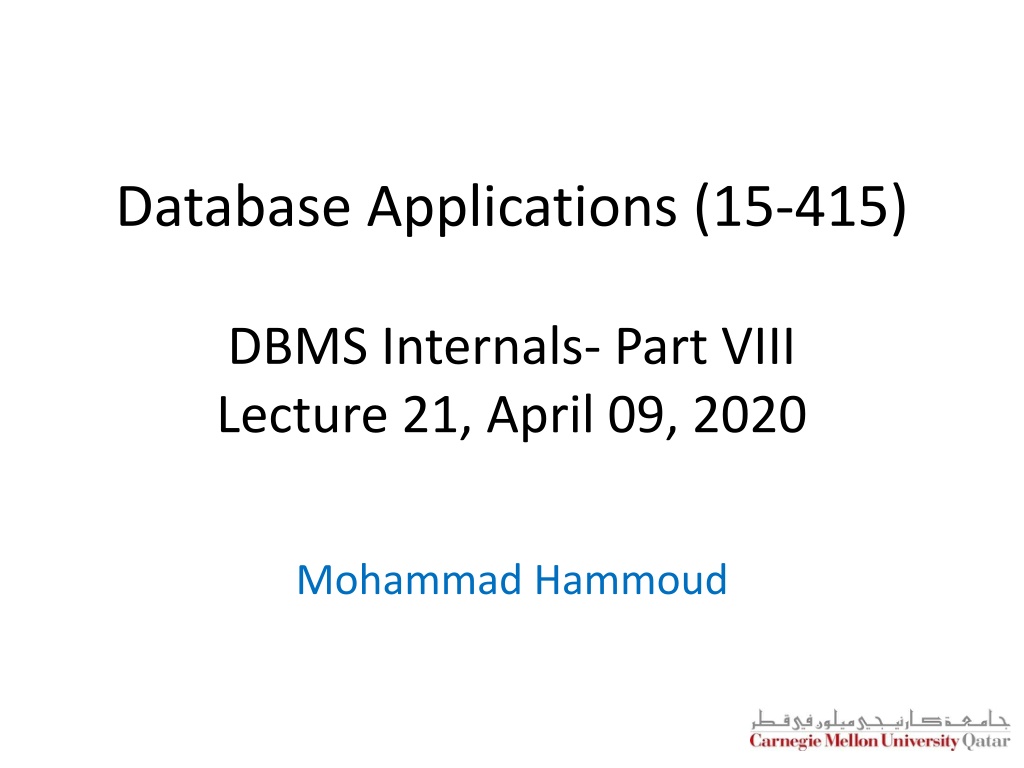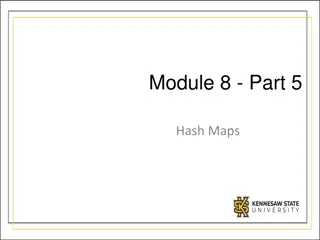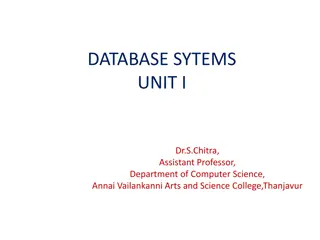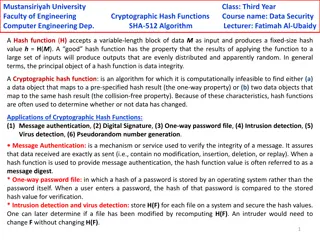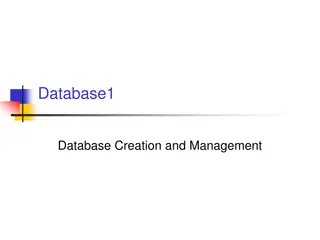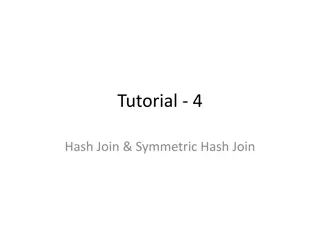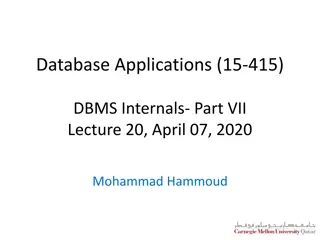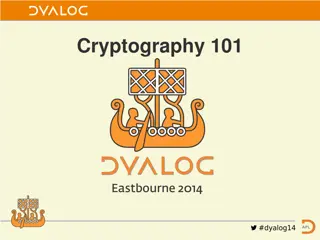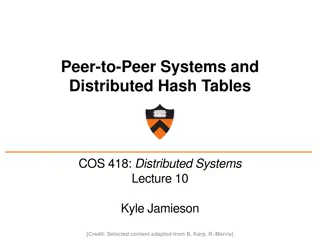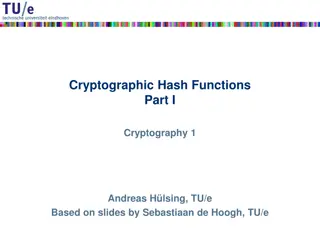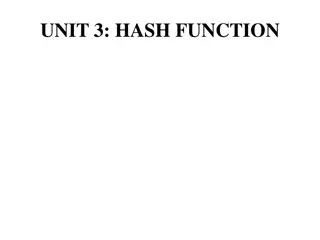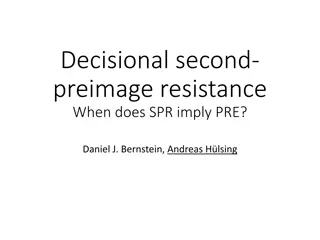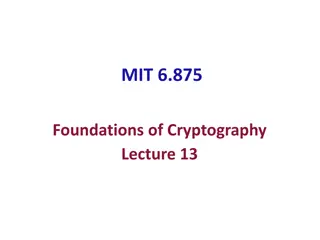Understanding Hash Join Algorithm in Database Management Systems
In this lecture, Mohammad Hammoud explores the Hash Join algorithm, a fundamental concept in DBMS query optimization. The algorithm involves partitioning and probing phases, utilizing hash functions to efficiently join relations based on a common attribute. By understanding the intricacies of Hash Join, database professionals can improve query performance and data processing efficiency.
- Hash Join
- DBMS query optimization
- Database Management Systems
- Relational Operations
- Query Processing
Download Presentation

Please find below an Image/Link to download the presentation.
The content on the website is provided AS IS for your information and personal use only. It may not be sold, licensed, or shared on other websites without obtaining consent from the author. Download presentation by click this link. If you encounter any issues during the download, it is possible that the publisher has removed the file from their server.
E N D
Presentation Transcript
Database Applications (15-415) DBMS Internals- Part VIII Lecture 21, April 09, 2020 Mohammad Hammoud
Today Last Session: DBMS Internals- Part VII Algorithms for Relational Operations (Cont d) Today s Session: DBMS Internals- Part VIII Algorithms for Relational Operations (Cont d) Introduction to Query Optimization Announcements: PS4 is due on April 15 P3 is due on April 18
DBMS Layers Queries Query Optimization and Execution Relational Operators Files and Access Methods Transaction Manager Recovery Manager Buffer Management Lock Manager Disk Space Management DB
Outline The Join Operation (Cont d) The Set Operations The Aggregate Operations Introduction to Query Optimization
The Join Operation We will study five join algorithms, two which enumerate the cross-product and three which do not Join algorithms which enumerate the cross-product: Simple Nested Loops Join Block Nested Loops Join Join algorithms which do not enumerate the cross-product: Index Nested Loops Join Sort-Merge Join Hash Join
Hash Join The join algorithm based on hashing has two phases: Partitioning (also called Building) Phase Probing (also called Matching) Phase Idea: Hash both relations on the join attribute into k partitions, using the same hash function h Premise: R tuples in partition i can join only with S tuples in the same partition i
Hash Join: Partitioning Phase Partition both relations using hash function h Two tuples that belong to different partitions are guaranteed not to match Original Relation Partitions OUTPUT 1 1 2 INPUT 2 hash function h . . . B-1 B-1 B main memory buffers Disk Disk
Hash Join: Probing Phase Read in a partition of R, hash it using h2 (<> h) Scan the corresponding partition of S and search for matches Partitions of R & S Join Result Hash table for partition Ri (k < B-1 pages) hash fn h2 h2 Output buffer Input buffer for Si B main memory buffers Disk Disk
Hash Join: Cost What is the cost of the partitioning phase? We need to scan R and S, and write them out once Hence, cost is 2(M+N) I/Os What is the cost of the probing phase? We need to scan each partition once (assuming no partition overflows) of R and S Hence, cost is M + N I/Os Total Cost = 3 (M + N)
Hash Join: Cost (Contd) Total Cost = 3 (M + N) Joining Reserves and Sailors would cost 3 (500 + 1000) = 4500 I/Os Assuming 10ms per I/O, hash join takes less than 1 minute! This underscores the importance of using a good join algorithm (e.g., Simple NL Join takes ~140 hours!) But, so far we have been assuming that partitions fit in memory!
Memory Requirements and Overflow Handling How can we increase the chances for a given partition in the probing phase to fit in memory? Maximize the number of partitions in the building phase If we partition R (or S) into k partitions, what would be the size of each partition (in terms of B)? At least k output buffer pages and 1 input buffer page Given B buffer pages, k = B 1 Hence, the size of an R (or S) partition = M/B-1 What is the number of pages in the (in-memory) hash table built during the probing phase per a partition? f.M/B-1, where f is a fudge factor
Memory Requirements and Overflow Handling What do we need else in the probing phase? A buffer page for scanning the S partition An output buffer page What is a good value of B as such? B > f.M/B-1 + 2 Therefore, we need ~ M . B f What if a partition overflows? Apply the hash join technique recursively (as is the case with the projection operation)
Hash Join vs. Sort-Merge Join If (M is the # of pages in the smaller relation) and we assume uniform partitioning, the cost of hash join is 3(M+N) I/Os B M If (N is the # of pages in the larger relation), the cost of sort-merge join is 3(M+N) I/Os B N Which algorithm to use, hash join or sort-merge join?
Hash Join vs. Sort-Merge Join If the available number of buffer pages falls between and , hash join is preferred (why?) N M Hash Join shown to be highly parallelizable (beyond the scope of the class) Hash join is sensitive to data skew while sort-merge join is not Results are sorted after applying sort-merge join (may help upstream operators) Sort-merge join goes fast if one of the input relations is already sorted
The Join Operation We will study five join algorithms, two which enumerate the cross-product and three which do not Join algorithms which enumerate the cross-product: Simple Nested Loops Join Block Nested Loops Join Join algorithms which do not enumerate the cross-product: Index Nested Loops Join Sort-Merge Join Hash Join
General Join Conditions Thus far, we assumed a single equality join condition Practical cases include join conditions with several equality (e.g., R.sid=S.sid AND R.rname=S.sname) and/or inequality (e.g., R.rname < S.sname) conditions We will discuss two cases: Case 1: a join condition with several equalities Case 2: a join condition with an inequality comparison
General Join Conditions: Several Equalities Case 1: a join condition with several equalities (e.g., R.sid=S.sid AND R.rname=S.sname) Simple NL join and Block NL join are unaffected For index NL join, we can build an index on Reserves using the composite key (sid, rname) and treat Reserves as the inner relation For sort-merge join, we can sort Reserves on the composite key (sid, rname) and Sailors on the composite key (sid, sname) For hash join, we can partition Reserves on the composite key (sid, rname) and Sailors on the composite key (sid, sname)
General Join Conditions: An Inequality Case 2: a join condition with an inequality comparison (e.g., R.rname < S.sname) Simple NL join and Block NL join are unaffected For index NL join, we require a B+ tree index Sort-merge join and hash join are not applicable!
Outline The Join Operation (Cont d) The Set Operations The Aggregate Operations Introduction to Query Optimization
Set Operations R S is a special case of join! Q: How? A: With equality on all fields in the join condition R S is a special case of join! Q: How? A: With no join condition How to implement R U S and R S? Algorithms based on sorting Algorithms based on hashing
Union and Difference Based on Sorting How to implement R U S based on sorting? Sort R and S Scan sorted R and S (in parallel) and merge them, eliminating duplicates How to implement R S based on sorting? Sort R and S Scan sorted R and S (in parallel) and write only tuples of R that do not appear in S
Union and Difference Based on Hashing How to implement R U S based on hashing? Partition R and S using a hash function h For each S-partition, build in-memory hash table (using h2) Scan R-partition which corresponds to S-partition and write out tuples while discarding duplicates How to implement R S based on hashing? Partition R and S using a hash function h For each S-partition, build in-memory hash table (using h2) Scan R-partition which corresponds to S-partition and write out tuples which are in R-partition but not in S-partition
Outline The Join Operation (Cont d) The Set Operations The Aggregate Operations Introduction to Query Optimization
Aggregate Operations Assume the following SQL query Q1: SELECT AVG(S.age) FROM Sailors S How to evaluate Q1? Scan Sailors Maintain the average on age In general, we implement aggregate operations by: Scanning the input relation Maintaining some running information (e.g., total for SUM and smaller for MIN)
Aggregate Operations Assume the following SQL query Q2: SELECT AVG(S.age) FROM Sailors S GROUP BY S.rating How to evaluate Q2? An algorithm based on sorting An algorithm based on hashing Algorithm based on sorting: Sort Sailors on rating Scan sorted Sailors and compute the average for each rating group
Aggregate Operations Assume the following SQL query Q2: SELECT AVG(S.age) FROM Sailors S GROUP BY S.rating How to evaluate Q2? An algorithm based on sorting An algorithm based on hashing Algorithm based on hashing: Build a hash table on rating Scan Sailors and for each tuple t, probe its corresponding hash bucket and update average
Aggregate Operations Assume the following SQL query Q2: SELECT AVG(S.age) FROM Sailors S GROUP BY S.rating How to evaluate Q2 with the existence of an index? If group-by attributes form prefix of search key, we can retrieve data entries/tuples in group-by order and thereby avoid sorting If the index is a tree index whose search key includes all attributes in SELECT, WHERE and GROUP BY clauses, we can pursue an index-only scan
Outline The Join Operation (Cont d) The Set Operations The Aggregate Operations Introduction to Query Optimization
DBMS Layers Queries Query Optimization and Execution Relational Operators Files and Access Methods Transaction Manager Recovery Manager Buffer Management Lock Manager Disk Space Management DB
Cost-Based Query Sub-System Select * From Blah B Where B.blah = blah Queries Usually there is a heuristics-based rewriting step before the cost-based steps. Query Parser Query Optimizer Plan Generator Plan Cost Estimator Catalog Manager Schema Statistics Query Plan Evaluator
Query Optimization Steps Step 1: Queries are parsed into internal forms (e.g., parse trees) Step 2: Internal forms are transformed into canonical forms (syntactic query optimization) Step 3: A subset of alternative plans are enumerated Step 4: Costs for alternative plans are estimated Step 5: The query evaluation plan with the least estimated cost is picked
Required Information to Evaluate Queries To estimate the costs of query plans, the query optimizer examines the system catalog and retrieves: Information about the types and lengths of fields Statistics about the referenced relations Access paths (indexes) available for relations In particular, the Schema and Statistics components in the Catalog Manager are inspected to find a good enough query evaluation plan
Cost-Based Query Sub-System Select * From Blah B Where B.blah = blah Queries Usually there is a heuristics-based rewriting step before the cost-based steps. Query Parser Query Optimizer Plan Generator Plan Cost Estimator Catalog Manager Schema Statistics Query Plan Evaluator
Catalog Manager: The Schema What kind of information do we store at the Schema? Information about tables (e.g., table names and integrity constraints) and attributes (e.g., attribute names and types) Information about indices (e.g., index structures) Information about users Where do we store such information? In tables, hence, can be queried like any other tables For example: Attribute_Cat (attr_name: string, rel_name: string; type: string; position: integer)
Catalog Manager: Statistics What would you store at the Statistics component? NTuples(R): # records for table R NPages(R): # pages for R NKeys(I): # distinct key values for index I INPages(I): # pages for index I IHeight(I): # levels for I ILow(I), IHigh(I): range of values for I ... Such statistics are important for estimating plan costs and result sizes (to be discussed next week!)
SQL Blocks SQL queries are optimized by decomposing them into a collection of smaller units, called blocks A block is an SQL query with: No nesting Exactly 1 SELECT and 1 FROM clauses At most 1 WHERE, 1 GROUP BY and 1 HAVING clauses A typical relational query optimizer concentrates on optimizing a single block at a time
Translating SQL Queries Into Relational Algebra Trees select name from STUDENT, TAKES where c-id= 415 and STUDENT.ssn=TAKES.ssn TAKES STUDENT An SQL block can be thought of as an algebra expression containing: A cross-product of all relations in the FROM clause Selections in the WHERE clause Projections in the SELECT clause Remaining operators can be carried out on the result of such SQL block
Translating SQL Queries Into Relational Algebra Trees (Cont d) Canonical form TAKES STUDENT TAKES STUDENT Still the same result! How can this be guaranteed? Next class!
Translating SQL Queries Into Relational Algebra Trees (Cont d) Canonical form TAKES STUDENT TAKES STUDENT OBSERVATION: try to perform selections and projections early!
Translating SQL Queries Into Relational Algebra Trees (Cont d) Hash join; merge join; nested loops; Index; seq scan TAKES STUDENT How to evaluate a query plan (as opposed to evaluating an operator)?
Next Class Queries Query Optimization and Execution Continue Relational Operators Files and Access Methods Transaction Manager Recovery Manager Buffer Management Lock Manager Disk Space Management DB
